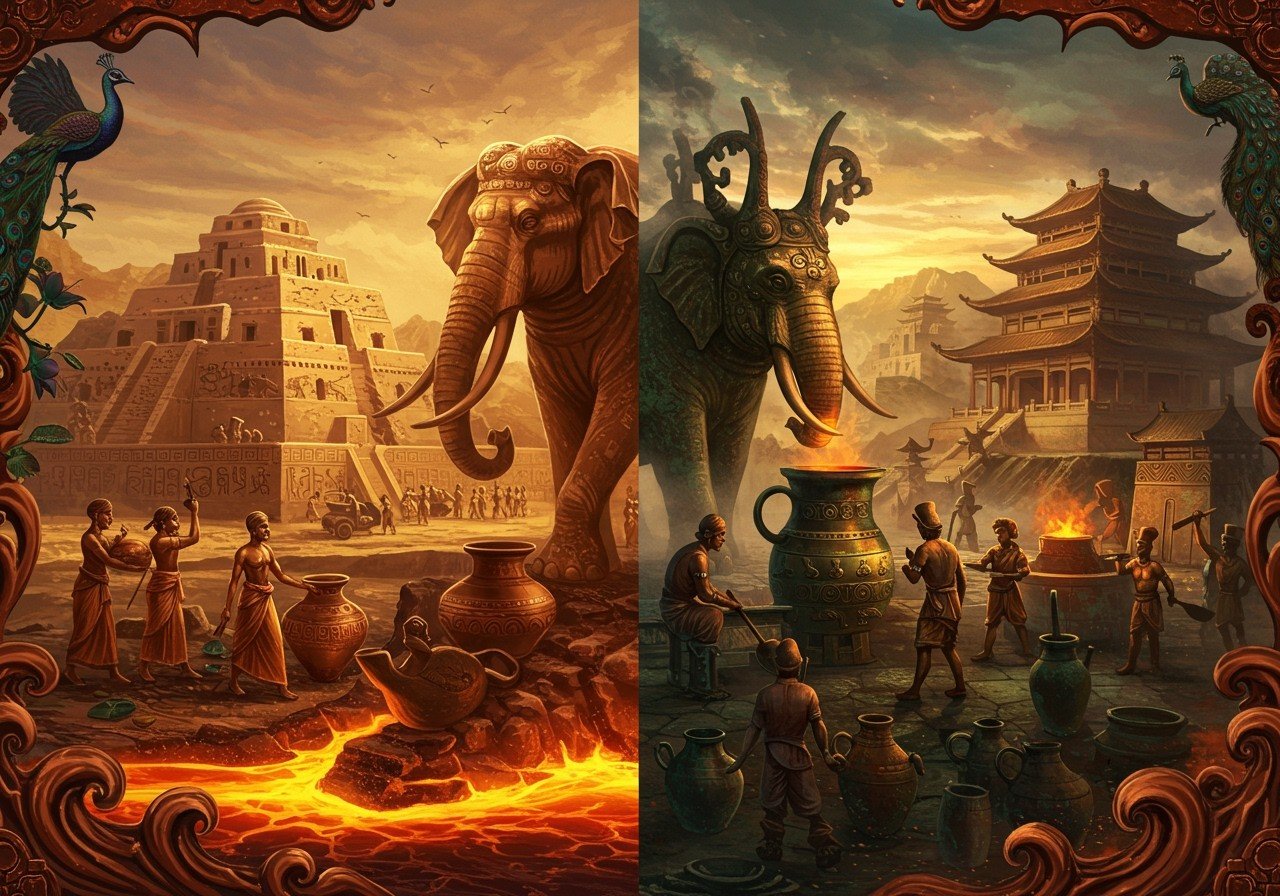
The Bronze Age, a pivotal era in human history, witnessed the rise of sophisticated civilizations across the globe. This period, characterized by the widespread use of bronze, saw significant advancements in urban development, technology, and societal structures. This comparative analysis delves into the Bronze Age civilizations of ancient India and China, exploring their unique characteristics, innovations, and lasting legacies.
India’s Bronze Age: The Indus Valley Civilization
The Indus Valley Civilization (c. 3300-1300 BCE) stands as a testament to the ingenuity of the Bronze Age in India. Flourishing along the Indus River, this civilization developed remarkable urban centers like Harappa and Mohenjo-Daro, showcasing advanced city planning and infrastructure.
Urban Planning and Infrastructure
- Grid System: Cities were meticulously planned with streets laid out in a grid pattern, demonstrating a sophisticated understanding of urban organization.
- Drainage Systems: An elaborate network of covered drains and sewage systems highlights the civilization’s emphasis on sanitation and public health. This advanced system was far ahead of its time.
- Standardized Weights and Measures: The use of standardized weights and measures facilitated trade and economic activities, indicating a well-organized and prosperous society.
Social Structure and Religious Practices
While the Indus script remains undeciphered, archaeological evidence reveals a complex social structure and rich religious traditions. Artifacts like the Great Bath suggest ritualistic practices, while seals depicting animals and deities offer glimpses into their spiritual beliefs.
Bronze Technology and Trade
The Indus Valley Civilization mastered the art of bronze metallurgy, crafting tools, weapons, and ornaments. Their engagement in extensive trade networks, spanning Mesopotamia and beyond, further fueled their economic growth and cultural exchange.
China’s Bronze Age: Xia, Shang, and Zhou Dynasties
Across the Himalayas, China’s Bronze Age unfolded with the rise of the Xia (c. 2070-1600 BCE), Shang (c. 1600-1046 BCE), and Zhou (c. 1046-256 BCE) dynasties. This era witnessed remarkable advancements in bronze casting, writing systems, and political organization.
Bronze Casting and Rituals
- Elaborate Vessels: The Chinese Bronze Age is renowned for its intricate bronze vessels, often used in rituals and ancestor worship. These vessels, adorned with elaborate designs and inscriptions, reflect the high level of craftsmanship and the importance of ritual practices.
- Technological Innovation: The development of sophisticated bronze casting techniques allowed for the creation of complex shapes and intricate designs, showcasing the mastery of metallurgy during this period.
Writing System and Political Organization
- Oracle Bones: The use of oracle bones, inscribed with early forms of Chinese writing, provides valuable insights into their beliefs, rituals, and political system. These inscriptions are crucial for understanding the development of Chinese writing.
- Centralized Power: The Shang dynasty established a centralized political system, with the king holding significant power and overseeing religious ceremonies and military campaigns.
Social Hierarchy and Agriculture
A rigid social hierarchy characterized ancient Chinese society, with the king and nobility at the top. Advancements in agriculture, particularly the cultivation of rice, supported a growing population and the development of urban centers.
Comparing and Contrasting
While both civilizations thrived during the Bronze Age, distinct differences emerged. The Indus Valley Civilization emphasized urban planning and sanitation, while the Chinese Bronze Age focused on bronze casting and ritual practices. Both, however, developed complex social hierarchies and engaged in extensive trade.
The Chalcolithic Period in India: A Precursor to the Bronze Age
Preceding the Bronze Age in India, the Chalcolithic period (Copper Age) saw the emergence of copper tools and regional cultures like Ahar-Banas and Malwa. This period laid the groundwork for the advancements of the Indus Valley Civilization.
Poojn.in: Connecting You to India’s Ancient Heritage
Poojn.in, India’s leading cultural goods and services store, offers a wide selection of products that reflect India’s rich heritage. Explore our collection of sacred malas, deities, and other ritual items, crafted with the same reverence and attention to detail as the artifacts of ancient India.
Conclusion
The Bronze Age civilizations of India and China left an indelible mark on human history. Their advancements in urban planning, technology, and social organization laid the foundation for future civilizations. By studying these ancient cultures, we gain a deeper understanding of our shared human heritage and the interconnectedness of the ancient world.
FAQs
What were the major cities of the Indus Valley Civilization? Harappa and Mohenjo-Daro were two of the most prominent cities of the Indus Valley Civilization.
What was the significance of bronze in ancient China? Bronze played a crucial role in ancient Chinese society, used for tools, weapons, and ritual vessels. It symbolized power and status.
How did the Indus script differ from the Chinese writing system? The Indus script remains undeciphered, while the Chinese writing system, originating from oracle bone inscriptions, evolved into the modern Chinese script.
What factors contributed to the decline of the Indus Valley Civilization? Several factors likely contributed, including climate change, shifts in river courses, and possible invasions or internal conflicts.


